Solar shade
Post from EditorialsTo avoid thermal overload using low emissivity glass and solar shading that intercept the light radiation before it reaches the fixtures.
Blinds to shield from the sun
The well-being in modern buildings comes through the selection of appropriate technical solutions to guarantee the standards of liveability and comfort.
This means that designers have an adequate understanding of the state of the art in the field of external partitions closing, whether the type of masonry, dry elements, glass walls or other types; the same reasoning, with more attention to the analysis of the existing, applicable to building renovation.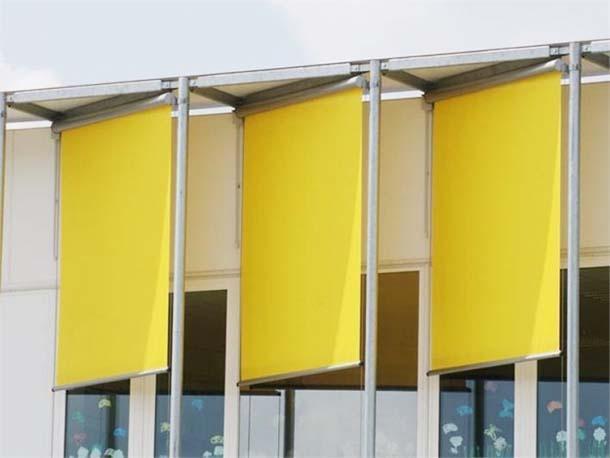
In the case of structures with large glass walls, created by joint decisions of designers and clients to achieve certain architectural effects or to adapt to specific functional needs, such as office buildings or type of production, the focus should be aimed at preventing the thermal overload of the external surfaces:
This condition is achieved by selecting particular types of low emissivity glass and especially by choosing to use the solar control louvres which intercept the light radiation before it reaches the fixtures.
The roller blinds model Prospecta of the company Suncover protect and complete a facade system.
They eliminate the possible glare effects, they reduce the contributions of solar thermal energy in and regulate natural light thanks to the layer of filter fabric Vetroscreen Suncover light gray.
An added value from the point of view of performance is the treatment with Ecosun Suncover titanium dioxide, stable and non-toxic material which, when in contact with sunlight acts as a natural purifier, eliminating pollutants and preventing the formation of bacteria and molds.
Its protection can last up to 10 years, as well as making the fabrics self-cleaning, advantage that helps the maintenance of internal and external blinds.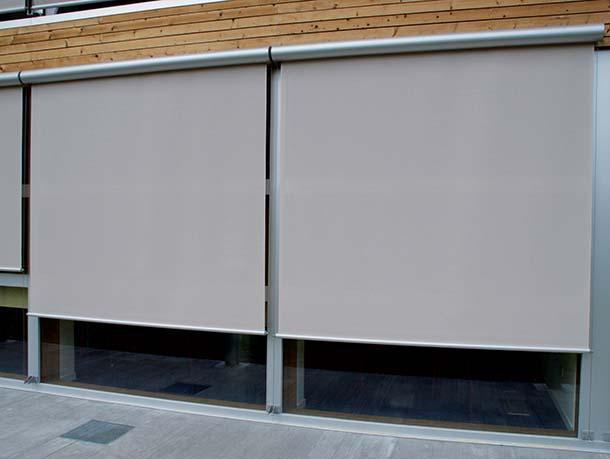
In the same product sector we find the curtains Sunscreen from the company Sunbreak, made of filtering fabric and characterized by various intensities of light transmission, up to total obscuration. They contribute to the living comfort that protect the environment.
The wide range of types and solutions enables to solve every design requirements and to enhance the architecture of the buildings while they get specific performance protection of the exposed walls.
The choices range from cassette awnings in round section (100-120-160 mm) tensioned awnings horizontal and vertical, like the model Sb 110 Ps for small and medium surfaces, with winding box 110 mm, cable guides in steel or extruded aluminum and compensator, which keeps the cloth always in tension even during winding, without the unsightly folds.
Sunscreen products are also available in different typologies, to accommodate the choices of the designers and the same morphology of the building.
Among the many we include the version inclined guides suitable for balconies of the 120 Sb model, the box round section 120 mm in diameter, with curtains in polyester coated with PVC, proposed version inclined to embrace the hill outside .
The final look of this type of product, which recalls the shape of a panel taut, elevates these elements almost to the level of a structural component of the facade.
Traditional solar shading
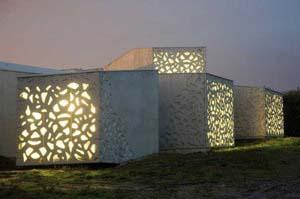 From the East a system of protection from the sun that is taken by contemporary architecture both for its function is to connote the outside of a building with great style.
From the East a system of protection from the sun that is taken by contemporary architecture both for its function is to connote the outside of a building with great style.
We speak of mashrabiya, which takes its name from a particular type of wood carving used in windows as shielding and is a traditional passive cooling system, typical of the Middle East and some areas of North Africa.
Originally it identified that part of the building projecting, with openings formed by grate wood that was used to obtain simply adequate welfare humidity internal environments and that was generally used as a place of sharing because, placed in the cooler areas, became space rallies, and rest areas where you can have drinks together.
Today are still defined mashrabiye those openings screens, formed by wooden gratings, discrete, useful and elegant, with more or less dense patterns, that perform various functions: a kind of weaving of separation designed to allow air and light to filter between spaces, to vary the intensity of the pattern, the height of the screen and place where it is placed.
The mashrabiya can perform functions of temperature and humidity, but also of simple solar shading.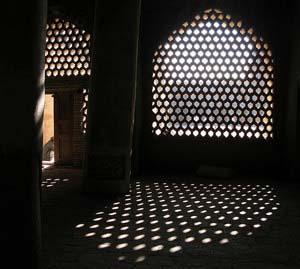 Technologically the Mashrabiya exploits the physical characteristics of the wood, according to the climatic conditions of the place where it is located.
Technologically the Mashrabiya exploits the physical characteristics of the wood, according to the climatic conditions of the place where it is located.
It depends primarily on the type of wood used: if it is not treated or coated is able to absorb or release water.
Operation is biphasic: at night the wind passes through the wooden grates of the Mashrabiya, giving the material its moisture.
During the day, however, when the sun beats, the wood releases this stored moisture, thus promoting the climate of the interior.
Generally Mashrabiye facing north or in situations of particular traffic and crowding, are the textures of wood thinner and denser.
The plots are also used to repair from prying eyes outside; therefore, the most modern have a design more dense from the bottom upwards, which progressively thins out, until you get to full transparent glass in the top, to favor the lighting.
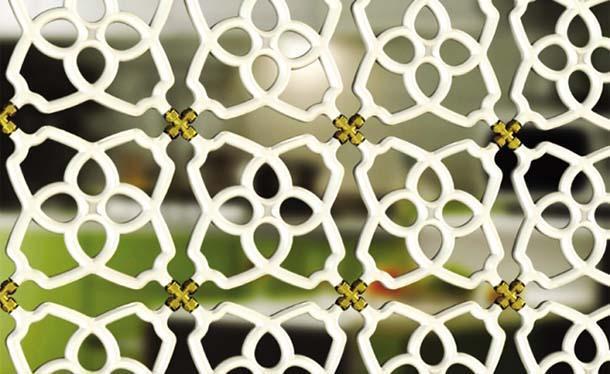
Mashrabiye are currently used in modern architecture as solar screens with great effect, more to the light, and for the appearance thermohygrometric, as in the case of the charming Metropol Museum of Lille in France Manuelle Gautrand.
But this type of shielding has also influenced some modern passive cooling systems: the recent Ecooler, designed by the Israeli people from Studio Kahn, is a ceramic cooling device, consists of ceramic tiles carrying and transferring water, which in turn refreshes the environment.
Metal solar shading
Among the more modern alternatives to classical systems for dimming, such as blinds, roller shutters or blinds there is a very innovative solution, which consists entirely of metallic solar shielding, constituted by adjustable rigid blades. 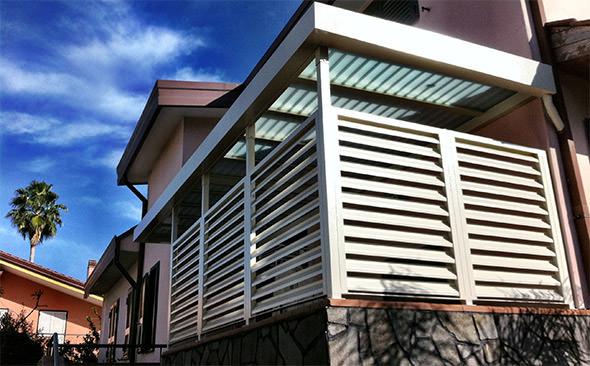
It is a shading exterior roller shutter packet, much like a venetian metal, which, however, does not provide for vertical belts visible connecting and lifting between one blade and the other.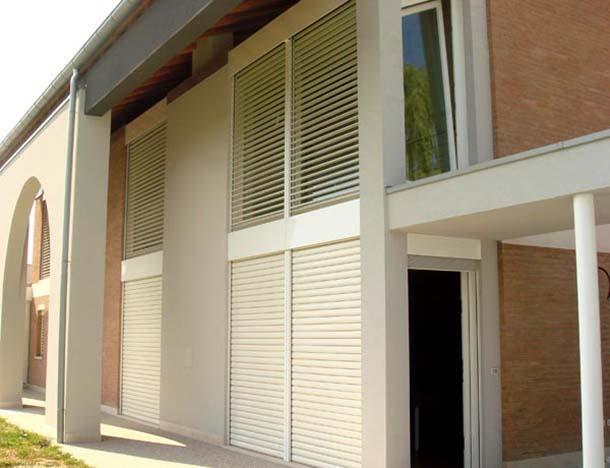
This system is able to respond to all the requirements obscuration solar, weather protection, safety, comfort and economy.
This type of shield also provides an important contribution to thermal insulation, both summer and winter, in front of which the casing is installed.
Unlike the classic Venetian tapes with external connection, the metallic mechanisms that raise and orient the slats are hidden in the self-supporting side guides and consist of a chain of strong steel bars, which can be motorized or manually operated.
Each blade is anchored to the two ends into the lateral guides, with robust supports, which allow to replace from within each individual slat which in time may be worn out.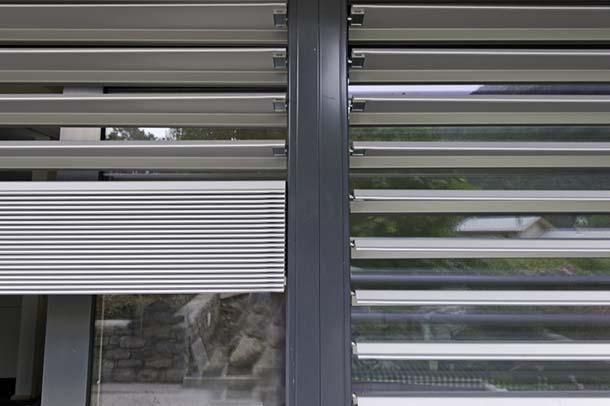
The drive can be manual, via an oscillating rod aluminum or powered by single phase electric motor operating at 230V and 50Hz. It is then possible to operate more shading from the same command.
In addition to a safety locking device against intrusion from the outside, the metal plates are also equipped with a built-in protection that causes are not damaged in the case where there are accidentally interposed objects which would impede the descent: in this case the end fence disengages mechanically.
Model System Italy offers the all-metal blind Modelpak MD 400, with the blades slightly rounded shape specially designed for resistance to bending with an integrated damping profiles. It is available in a wide range of colors and shades, or the slats can be paneled with different woods and finishes.
Griesser proposes the blinds Metalunic metal, also available in an assortment of colors, grouped into four different collections: Glass & Stones, Sun & Fire, Water & Moss, Earth & Wood.
You can also choose the bicolor slats, ie with two different colors between the exterior and the interior.
79806 REGISTERED USERS










